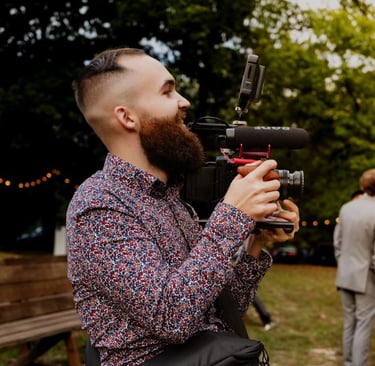Handheld vs. Gimbal: Which is Best for Wedding Videography?
The pros and cons of shooting handheld and gimbal.
2/9/20252 min read


As a wedding videographer, capturing beautiful, cinematic moments is key to delivering a film that couples will cherish forever. One of the biggest decisions you'll face when filming a wedding is whether to shoot handheld or use a gimbal. Both methods have their pros and cons, and choosing the right approach depends on your shooting style, the wedding environment, and the type of footage you want to achieve. Let’s break it down.
Shooting Handheld: The Pros & Cons
Pros:
Speed & Flexibility – Weddings are fast-paced, and sometimes you need to move quickly. Shooting handheld allows you to react instantly to fleeting moments without the setup or balancing time required for a gimbal.
Natural & Intimate Feel – A handheld camera provides an organic, raw look that can make the footage feel more personal and immersive, perfect for emotional moments.
Lightweight & Less Fatiguing – Without a gimbal, your rig is lighter, making it easier to shoot for long hours without getting fatigued.
Easier in Tight Spaces – Some wedding venues have limited space (small hotel rooms, crowded dance floors), where a gimbal can feel cumbersome. Shooting handheld allows you to maneuver more freely.
Better for Low Light – Gimbals can sometimes struggle in low light, especially if you need to use a fast lens and maintain stability. Handheld shooting allows you to adapt without worrying about motor jitters.
Cons:
Potential for Shaky Footage – Without proper stabilization techniques, handheld footage can look unsteady and unprofessional.
Not Ideal for Tracking Shots – If you need to follow a couple down the aisle or capture a smooth walking shot, handheld can be tricky to keep steady.
More Effort in Post-Production – Handheld footage often requires additional stabilization in editing, which can take extra time and may degrade video quality.
Shooting on a Gimbal: The Pros & Cons
Pros:
Smooth, Cinematic Footage – A gimbal provides incredibly smooth, fluid motion, making it ideal for elegant shots like walking sequences, first dances, and sweeping venue reveals.
Professional & Polished Look – Gimbal shots elevate production value, making wedding films look more high-end and cinematic.
Dynamic Motion Possibilities – You can achieve creative movements like push-ins, reveals, and orbiting shots that add depth and engagement to the video.
Less Need for Post-Stabilization – Because gimbal footage is naturally stable, it typically requires minimal or no stabilization in editing.
Cons:
Bulky & Heavy Setup – Gimbals add weight to your rig, which can lead to fatigue over long wedding days.
Slower to Set Up & Adjust – Balancing a gimbal takes time, and if you need to switch lenses or settings quickly, it can slow you down.
Can Feel Robotic – While smoothness is great, too much gimbal use can make a wedding film feel overly mechanical and less natural.
Limited in Low Light – Some gimbals can introduce micro jitters in low-light conditions, especially when using heavier lenses or slower shutter speeds.
Finding the Right Balance
The best approach is to use a combination of both techniques.
Use a gimbal for smooth establishing shots, walking sequences, and grand cinematic moments.
Shoot handheld for intimate, emotional scenes, quick reactions, and tight spaces.
Consider hybrid solutions like using a monopod or shoulder rig for additional stability without the limitations of a gimbal.
At the end of the day, your shooting style, personal preference, and the wedding environment will determine the best tool for the job. Master both handheld and gimbal techniques, and you’ll be prepared for any wedding scenario, delivering stunning films that couples will love.
What’s Your Preference?
Do you prefer shooting handheld or using a gimbal for weddings? Let us know in the comments!
